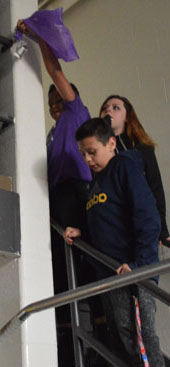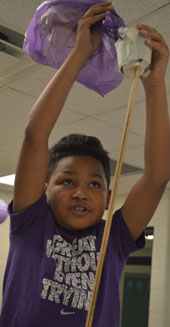Wyoming Intermediate School teacher Janet Norman’s sixth-grade students brainstormed during science class. They considered: What kind of packaging is strong enough for a drone to deliver a fragile item onto a doorstep?
“How would I design something and solve this problem?” Norman asked students working in teams.
See Related Story: Science Learning through Play, Discovery – As Next Generation Science Standards are implemented in classrooms nationwide, students are beginning to think like scientists as young as kindergarten, paving the way for years of experimentation, exploration and thinking their way through…
Students worked like engineers to design cushy containers with tape, cotton balls, packaging peanuts and bubble wrap. They related it to Amazon and its conceptual drone-delivery system.
The challenge was not only to prevent an egg from cracking when dropped from 2-, 2.5- and finally 5-meters. Students also needed to make the smallest and lightest product possible.
“If it fails, keep going back to the drawing board,” Norman said.
Design. Build. Test. Revise. That’s the daily plan in Norman’s class, where science means trial and error, discovery and discourse, whether in creating bio-domes for earthworms or testing erosion with sand and water.
After being dropped, many eggs remained intact. Student Anthony Walton was thrilled. His four-member team, Oomi Zoomi, had successfully created a cottony container nestling the egg. “I can’t believe ours made it,” he said.
Norman’s teaching incorporates Next Generation Science Standards, a set of teaching guidelines for kindergarten through 12th-graders outlined in “A Framework for K-12 Science Education.” Norman has studied an approach called inquiry-based science for years, through training and programs offered by Grand Valley State University, Calvin College, Aquinas College and the Van Andel Institute.
NGSS, adopted in November by the Michigan Department of Education, seems like a natural fit for the teacher who’d rather see students engage in experiments than lecture or read from a textbook.
“You cannot do science sitting in a chair,” Norman said.

Propose, State, Provide, Support
Norman’s way of teaching is becoming more and more common as the days of studying science from a textbook, completing a lab exercise and taking a test come to a close.
Seventeen states, including Michigan, have adopted the NGSS standards. The state is enhancing it with a “Michigan-centric” version called Michigan Science Standards, which adds local connections. For example, second-grade students must obtain information about where water is found on the Earth. Here, they focus on the Great Lakes basin, said Wendi Vogel, Kent ISD Science consultant.
“NGSS is a very heavily research-based set of standards,” Vogel said, noting they combine 30 to 40 years of best practices. “Its vision is that students need to be more like scientists and engineers. We want them to really think about how to ask questions and solve problems.”
Experiments are not cut and dried. Students redesign, rebuild and tweak as manytimes as it takes, filling data notebooks with “quantitative” (numerical) and “qualitative” (size, appearance and value) information as they go.
They propose answers, state a claim, provide evidence and support it.
“I like watching them go through the process,” said Norman, noting that students are at first bewildered. When they ask a question, Norman asks another back. Soon they say, “You’re just going to ask me another question, aren’t you?”
While following that outline, they learn science concepts like force-of-motion, gravity, pressure and Newton’s Law of Motion. They observe them, rather than simply memorizing.
“Science, Technology, Engineering and Math (STEM) weaves into the whole lesson plan,” Norman said.
Sixth-grader Lizzie Ochoa finds it all pretty exciting. “Instead of looking at it in books. We’re seeing it in real-life,” she said. The class has also zeroed in on their surroundings using Google Maps, grown winter pansies to study how light affects them, testing erosion with sand and water and raised earthworms in completely sealed two-liter bottles.
“The experiments are fun. It’s so interesting to find out what happens,” added sixth-grader Jenna Vander Ploeg.
“You learn more by experimenting,” chimed in sixth-grader Chloe Ricker. “If you just look at a textbook you won’t register as much.”

A Framework Created by Scientists
NGSS was created by the National Research Council of the National Academy of Science through a committee of 18 individuals who are internationally known in their respective fields. The committee included two Nobel laureates, cognitive scientists, science education researchers, standards and policy experts.
A major focus is “cross-cutting” concepts, meaning students explore connections across the four domains of science, including Physical Science, Life Science, Earth and Space Science, and Engineering Design. That’s because in real life there’s a lot of interaction between domains.
“This is good stuff. It’s good science. It’s kids behaving like scientists in science,” said Heather Robotham, Wyoming Public School K-6 science consultant, who is helping implement NGSS.
Robotham and several other Wyoming teachers have become trained in NGSS with the Kent Science Team, a Kent ISD network of science educators.
NGSS at a Secondary Level
Godwin Heights Public Schools started incorporating NGSS two years ago, in advance of the state’s adoption of it. Science teachers Katie Hoffman and Tonia Sorokin have helped implement it at the middle and high school.
At a recent Godwin High School Science Night, students led stations highlighting how they use science to race “puff” cars, made of paper, straws, tape and lifesaver mints for the wheels. They challenged people to blow on the cars and see which one rolled the furthest. They extracted DNA from strawberries, and make aluminum cans implode by heating them up and then using tongs to drop them in cold water.
“The biggest change is that it’s much more engineering-based so it’s much more hands-on. It’s not just knowing it but applying the information. We’ve tried to incorporate a lot of that into projects,” said Hoffman. “We are trying to make it much more realistic.”

A green-roof project in Earth Science allowed students to research how different kinds of roofs absorb or reflect heat and impact the environment and the amount of energy a facility uses. They created proposals for Godwin administration including benefits, drawbacks and the cost of various roofing products and installations.
In anatomy, students created a presentation on drugs and their chemical effect on the brain.
In forensics, students identify suspects in a crime-scene investigation and learn blood typing to in a reality-show style investigation of determining the paternity of a child
“I like the projects,” said junior Kevin Lemos. “I think with the new standards I feel like I’m getting more engaged into science instead of sitting there taking notes and not remembering it. Im actually getting into science and working with it.”
Kevin wrote a proposal in Earth Science on how he would use 70 acres of land to affect the environment while bettering the economy and life. Students presented the projects to each other in a simulated City Council session.
“We had to come up with a way to try to not affect the ecosystem but bring in a significant amount of income.We found ways to increase farming and we used clean energy including solar panels,” he said. “What I got from it is how things in the real world would go to make a society.”
Godwin teachers are crossing subjects as well as domains with NGSS. In art class, Godwin Heights students have learned eye parts including rods and cones, which fit in with anatomy. In gym they focus on muscles, also tying back to anatomy.
Working to Align with State Test
A frustration among teachers is that NGSS fails to align with M-STEP, the state’s standardized test. That will soon change, Vogel explained.
State policy-makers and science content and assessment specialists are working this summer to create a state assessment aligned with NGSS. Prototype items, developed by WestEd, are in development with pilot tests planned next spring and continuing over the next few years until a switch to the new assessment in 2019 or 2020.
Teachers and science consultants will work this summer on aligning the state assessment with NGSS and introducing prototype items to be piloted next spring and for the next few years, with a full switch in 2019 or 2020, Vogel said.









